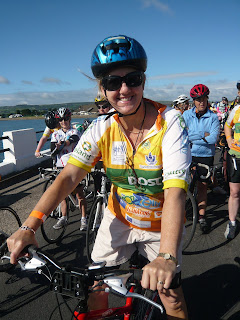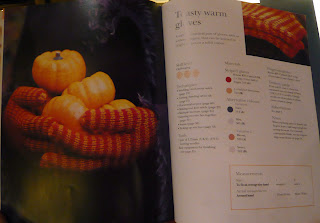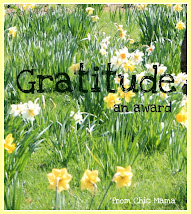 I did it! I took part in my first cycling event today and absolutely loved it - the 50km Sean Kelly Cruise in the Tour of Waterford 2010. Long-time readers of this blog will know that hubby Jan did this cycling challenge for the past few years and I have been on the sidelines to cheer him on and welcome him past the post last year, which is documented here.
I did it! I took part in my first cycling event today and absolutely loved it - the 50km Sean Kelly Cruise in the Tour of Waterford 2010. Long-time readers of this blog will know that hubby Jan did this cycling challenge for the past few years and I have been on the sidelines to cheer him on and welcome him past the post last year, which is documented here.This year was different though. I got a bike for my birthday in March, and you can read about it here - it's a lovely lipstick red Hybrid Kelly's Kappa bike, part touring, parttown bike. Suits me to a tee, and I even got a basket much to the horror of the cycling purists in the family. It's black wire mesh and detaches from a small fitting on the handlebars, and is perfect for those little forgotten messages (= things from the shop - a peculiar Hiberno-English-ism which tends to confuse anyone unfamiliar with our oft-obscure terminology). I knew Jan was planning his assault on the 90km Coastal Route, which was pretty daunting as it traversed plenty of steep climbs which would challenge the pros, let alone the amateur enthusiast. I wondered whether I'd be able for the 50km and decided to get a bit of training done. Shayne, our eldest son, decided to go on this one too, using his dad's old racer.
So since June/July I've been cycling regularly, about three times a week, from a 15km cycle a couple of evenings after work to a longer one at weekends - the longest being39km. Not alone did I surprise myself at my ability to cope with the longer runs, but I felt great afterwards, despite being exhausted when I came home at first. My stamina improved very quickly as did my speed andIenjoyed seeing the proof of my progress when Jan logged it onto a nice Excel spreadsheet with line graphs as evidence. For example (without getting pedantic or too boring!) the first 15km I did took just over an hour, whereas now I can do it in about 50minutes. I knocked 9 mins off a 22km run in the space of three weeks, which I felt very smug and virtuous about. I got plenty of encouragement from Jan and the family and also colleagues at work, some of whom were participating themselves or had family members taking part.

The great thing about this cycle is that it's all about fun. There's a professional element to the longest run, 160km, and then for the amateur enthusiast like hubby there's the 90km run. That's along a rugged coastal road with lots of steep inclines and some spectacular scenery - the Copper Coast and Geopark are famous for their beauty and historic significance in the Bunmahon area of Co. Waterford and the scenery might serve to distract the cyclist from the pain inthose calf and thigh muscles on the climbs!

The 160km mountain trail is for the serious amateurs and the professionals who enjoy a day's stage equal to an Etape in something like the Tour de France or the Giro or Vuelta. There's steep mountain passes to negotiate and endurance is needed to keep going to the end. So not for the fainthearted, and it was evident in the numbers that the 160km drew the biggest crowd and that cycling is fast becoming one of Ireland's most popular leisure and sporting activity.

The 50km started cycle for the beginners like me and eldest son Shayne was perfect - short enough to be attainable without huge time commitment and long enough to give a good adrenaline rush and an immense sense of satisfaction. And there was plenty of time to enjoy the view. The scenery from Dungarvan to Cappoquin via Ballinameela and Villierstown is beautiful especially the Villierstown-Cappoquin section which runs parallel to the Blackwater River and foms part of theDromanaDrive, a scenic route along back roads in the lands once owned by the local governor Lord Villiers-Stuart for whomVillierstown is named. Nowadays Villierstown is famous for an Olympic medallist John Treacy who won Silver in the 1984 Los Angeles Olympics in the Marathon. Today Villierstown was transformed into a haven for cyclists, who were given refreshments at the first water stop of the day. A very welcome break after 23km and I enjoyed the banana and Flahavan's Flapjacks (locally made in Kilmacthomas - supporting local produce is a hallmark of these events).

In Cappoquin we had a food stop in the magnificent new Community Centre, and I had to laugh to see the bikes thrown around outside in seemingly random fashion - everyone being very trusting. Shayne was on a racer and he went ahead quite early on, and we didn't meet up till Cappoquin when he passed me on the home stretch while I was heading for the food stop. We had pasta and sandwiches and delicious Barron's Brack, with hot tea and plenty of meeting up with other cyclists and some friends who were around the hall. The home stretch to Dungarvan was along the N72, the main road I drive daily to work. It was a lovely run with gentle hills and hollows, and a nice tail wind to push us along. I felt no pain and apart from the odd numb bum, which was alleviated by dismounting for a few minutes rest every 15km or so, I felt great at the end. Shayne and me waited for Jan to return from the 90km, which he duly did, and it was a far greater challenge than ours, as some of the hills were so steep many had to dismount to walk them.
We took some photos at the start and finish, and a few along the way of the rest stops. We collected our certificates of achievement at the end, and I will be very proud of mine, as I hope it will be the first of many Tours of Waterford for this keen cyclist. By the way, my time was 2hrs and 30 mins for 44km, which was what I clocked up - my speedometer wasn't connecting at the start - but I am very happy with that - average speed was over 17km/hr, given the crowds that was pretty good, as there was little opportunity for setting a pace along those narrow roads for the first 15km. So if you are contemplating a new hobby or some gentle exercise, you could do worse than to take up cycling - I did after a 30 year gap and it got bridged in no time.




























































